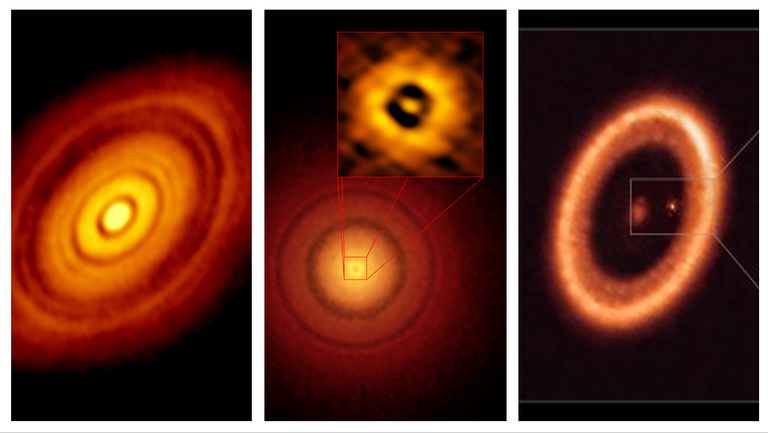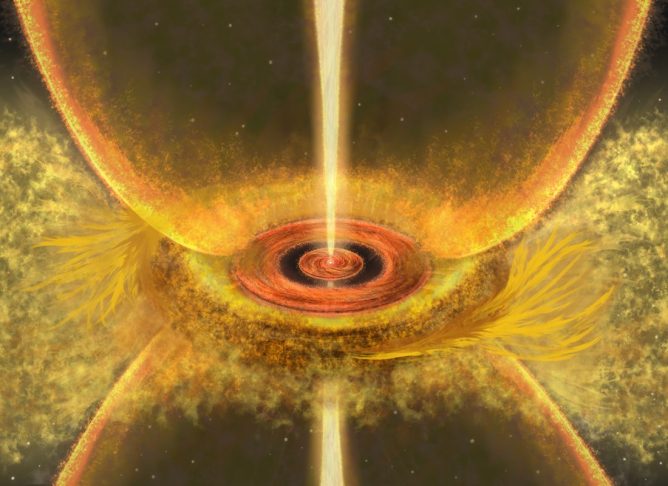Star formation is a hidden event, at least in its very early stages. Stellar crèches are veiled by clouds of gas and dust. Those same clouds also shield planet formation, particularly in the very beginning. So, astronomers don't always get to see the action until the dust has cleared. Although the newly forming planets are too small to see, their gravity stirs up spiral and ring patterns in the so-called protoplanetary disks around the newborn stars. So, when do those patterns begin to appear in the birth process?
A team of astronomers in Japan, led by Ayumu Shoshi of Kyushu University and the Academia Sinica Institute of Astronomy and Astrophysics, used observations from the Atacama Large Millimeter Array in Chile to take a closer look at star-forming disks in the Ophiuchus region. They used data from two projects: Early Planet Formation in Embedded Disks (eDisk) and Disk Substructures at High Angular Resolution Project (DSHARP), plus data about other regions to study many different disks. Among other things, their work showed clear evidence of spiral and ring structures in some protoplanetary disks and that planets began forming in larger disks a few hundred thousand years after their stars were born.
“These findings, bridging the gap between the eDisk and DSHARP projects, were enabled by the innovative imaging that allows for both achieving high resolution and a large number of samples,” said Ayumu Shoshi. "While these findings only pertain to the disks in the constellation Ophiuchus, future studies of other star-forming regions will reveal whether this tendency is universal.”
Based on additional work done by the Japanese team studying other starbirth regions, the discovery of "early starts" in planet formation helps to fill in more details about the whole process of star- and planet creation. The evolution of spiral and ring substructures in the circumstellar disks gives clues to planet-disk interactions as new worlds coalesce.
The General Process of Star Formation
Astronomers still know quite a bit about the general process of starbirth, despite the fact that these things start out shrouded. It begins when a cloud of gas and dust (a HII region) begins to coalesce as its self-gravity pulls material toward a central point. That "core" area is where a protostar begins to take shape. Eventually, when temperatures and pressures are high enough, nuclear fusion in the so-called "stellar core" begins, and as the old saying goes, a star is born.
At that point, the newborn star is still surrounded by the thick cloud of gas and dust that makes up its crèche. Eventually, if conditions are right, planets begin to form inside that protoplanetary disk. The contents of the cloud define the types of planets that will form, along with their placement. Our own Solar System went through this process beginning about 4.6 billion years ago inside an HII region about 65 or so light-years across. The Sun formed in the center of the coalescing mass, and the rest of the cloud collapsed to form the protoplanetary disk around it. Fragments of planet-building material were grains that formed at least 4.5 billion years ago. Some of those grains may actually be much older and predate the start of the Sun's formation. As the disk spun, those grains also began to coalesce, forming planetesimals that crashed together to make the planets we know today. Eventually the birth cloud is used up or dissipated during the planet-forming stages.
 ALMA images of a dusty disk around the star HL Tau, showing ringed structure and a gap at 1 AU from the forming star. The structure is likely being created by gravitational interactions with a possible planet in the disk. Our own Solar System might have looked like this some 4.5 billion years ago. Credit: ALMA/ESO.org
ALMA images of a dusty disk around the star HL Tau, showing ringed structure and a gap at 1 AU from the forming star. The structure is likely being created by gravitational interactions with a possible planet in the disk. Our own Solar System might have looked like this some 4.5 billion years ago. Credit: ALMA/ESO.org
One of the big questions about the process is: when do the worlds begin to form from those grains? Is it at the same time the star is coalescing? Or at some point after that? A lot depends on conditions in the cloud, plus any outside influences (such as passing stars, nearby supernova explosions, etc.). The timing is still pretty uncertain. That's why the Japanese team decided to take a closer look at the formation of substructures in other protoplanetary disks. Their ages could give clues to just when planets get their start.
Using ALMA to Peek Into the Planetary Crèche
The ALMA detectors are no strangers to protoplanetary disk observations. Radio and millimeter-range astronomy is well-suited to finding details in the dusty starbirth regions and astronomers use various ALMA programs to study the process. The DSHARP program found very obvious structures in 20 young stars that had been forming for at least a million years. Another approach, called eDisk, looked at disks around 19 protostars in the accretion phase (the stage where mass accretion onto the star and the disk is active). That step in star and planet formation usually happens about 10,000 to 100,000 years after starbirth. The differences in the planet-forming stages in each set suggest that disks have diverse characteristics depending on the age of the star.
 Artist’s impression of the distinctive substructure in a protoplanetary disk formed a few hundred thousand years after the birth of the central star. Credit: Y. Nakamura, A. Shoshi et al.
Artist’s impression of the distinctive substructure in a protoplanetary disk formed a few hundred thousand years after the birth of the central star. Credit: Y. Nakamura, A. Shoshi et al.
Those findings next raise the question: when exactly do the substructures (which are obvious signs of planetary formation) begin to show up in protoplanetary disks? The team combined the Ophiuchus sample with data from the eDisk project and analyzed them together. They found the disk substructures emerging in disks with radii larger than 30 AU during the early stages of star formation. That happens as early as a few hundred thousand years after a star is born and suggests planets begin to form at a much earlier stage when the disk still possesses abundant gas and dust. In other words, planets grow together with their very young host stars.
The next steps are to survey more circumstellar disks in all stages of stellar formation. Such surveys will provide a larger sample of systems to characterize and shed more light on the earliest epochs of planetary birth.
For More Information
New Insights into Planet Formation from Public Data with New Imaging Technique
New Super-resolution Imaging Reveals the First Step of Planet Formation after Starbirth

